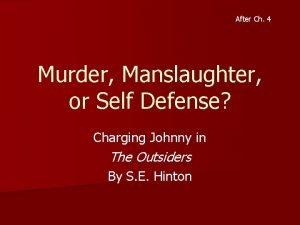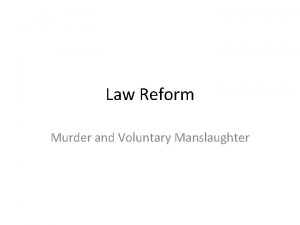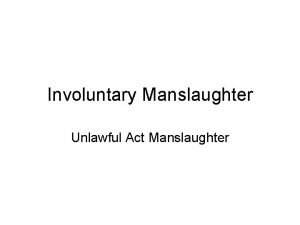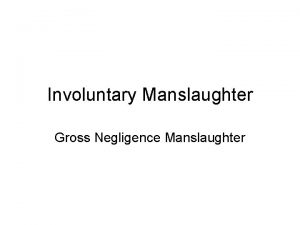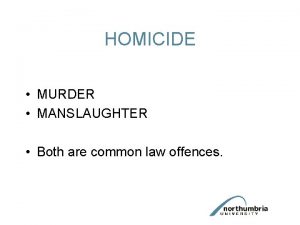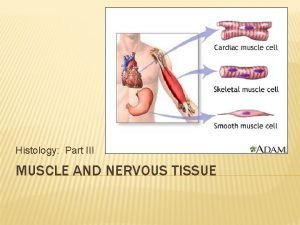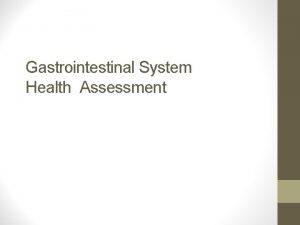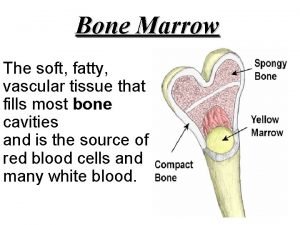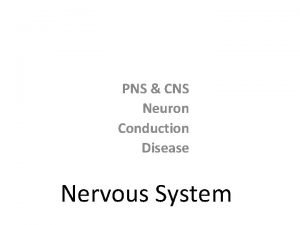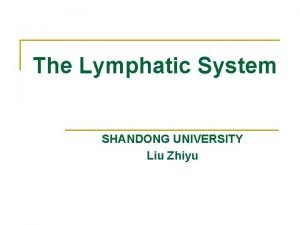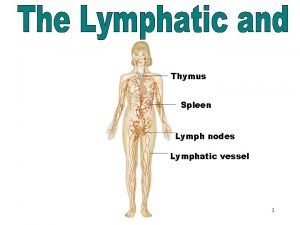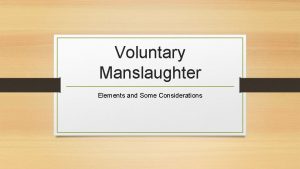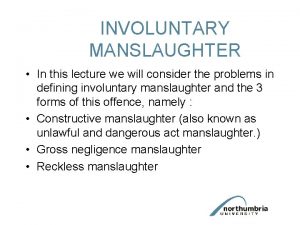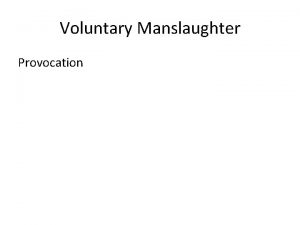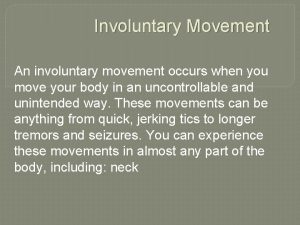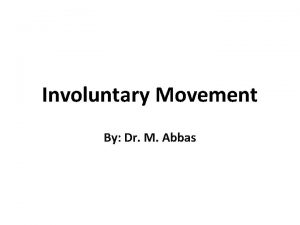Involuntary Manslaughter Involuntary Manslaughter There are two forms





























- Slides: 29

Involuntary Manslaughter

Involuntary Manslaughter • There are two forms of involuntary manslaughter: – Manslaughter by unlawful and dangerous act (otherwise known as constructive manslaughter). – Gross negligence manslaughter.

Manslaughter by Unlawful and Dangerous Act • To prove the actus reus of this offence there must be: An act. – The act must be unlawful. – The unlawful act must have caused the death. – The unlawful act must also be dangerous. –

Manslaughter by Unlawful and Dangerous Act • The offence has to be committed by an act – an omission is not sufficient. • Lowe (1973) – The defendant’s neglect of his son led to his death. The Court of Appeal held that even if the omission is deliberate, this type of manslaughter cannot be committed by an omission.

Manslaughter by Unlawful and Dangerous Act • The act must be unlawful. • Franklin (1883) – The act must also be a criminal offence. – The defendant threw a crate off Brighton pier that hit a swimmer below causing their death. The act was considered by the courts to be a civil tort of trespass so could not lead to a conviction of manslaughter by unlawful and dangerous act. (He ended up being convicted of gross negligent manslaughter. )

Manslaughter by Unlawful and Dangerous Act • Sometimes the unlawful act is not always easy to find. • Lamb (1967) – The defendant and victim were playing with a revolver that had 2 bullets in but neither were opposite the firing pin. Neither realised that the barrel would spin when the trigger was pulled. As the victim had not been in fear, then no assault had occurred and the defendant was not liable. Ariobeke (1988) •

Manslaughter by Unlawful and Dangerous Act • When looking at whether the unlawful act caused the death, the same rules of causation apply as for murder. • Goodfellow (1986) – The act does not need to be directed at the victim. – The concept of transferred malice applies.

Manslaughter by Unlawful and Dangerous Act • There are problems with causation when the defendant has supplied the victim with an illegal drug. • Cato (1976) – the defendant and victim each prepared an injection of a mix of heroin and water, they then injected each other, with the result that the victim died. By injecting the victim with heroin , the defendant had committed an unlawful act of administering a noxious substance to the victim contrary to s. 23 of the Offences Against the Persona Act 1861. As the victim had died from the effects of the injection, the defendant was convicted of unlawful act manslaughter.

Manslaughter by Unlawful and Dangerous Act • There are problems with causation when the defendant has supplied the victim with an illegal drug. • The problem has been where the defendant has prepared the injection, handed the syringe to the victim and the victim has injection him / herself. • Dalby (1982) – the defendant supplied a drug to the victim, which the victim then self-injected and subsequently died. The defendant was convicted of manslaughter, on appeal the Court of Appeal quashed this conviction , it as held that although supplying the drug was an unlawful act, it was not the act of supplying which had caused the death, the injection was the cause of death and as this was a voluntary act by the victim, the chain of causation had been broken.

Manslaughter by Unlawful and Dangerous Act • There are problems with causation when the defendant has supplied the victim with an illegal drug. • Later cases suggested that in circumstances such as in the Dalby case, the defendant could be guilty; however the debate was finally settled in Kennedy (2007) when the House of Lords ruled that there was no unlawful act by the defendant, the act of self-injection was a voluntary intervening act which broke the chain of causation.

Manslaughter by Unlawful and Dangerous Act • • It is possible that in situations where the defendant has supplied the drugs that the defendant could be guilty of gross negligence manslaughter Dias (2002) – the defendant was a heroin addict , the victim was also a drug user but was not known to inject heroin. They were both living on the streets and they went into a block of flats and on the stairwell the defendant prepared a syringe of heroin and gave it to the victim who injected himself, the defendant also then injected himself. When the defendant came round he saw that the victim was very ill and he asked a passer-by to call an ambulance and then left the scene, the victim later died in hospital. On appeal the defendant’s conviction for unlawful act manslaughter was quashed, though the Court of Appeal suggested that a conviction for gross negligent manslaughter might be possible where a duty of care could be established.

Manslaughter by Unlawful and Dangerous Act • The act must be dangerous. • R v Church (1966) – An act is dangerous if it was one which “all sober and reasonable people would inevitably recognise must subject the other person to, at least, the risk of some harm resulting therefrom, albeit not serious harm”.

Manslaughter by Unlawful and Dangerous Act • Some harm. • It is not necessary for the sober and reasonable person to foresee the actual type of harm that the victim suffers, it is enough that the sober and reasonable person would foresee some harm JM and SM (2012) – JM lit a cigarette in a nightclub and was asked to leave, after some pushing and shoving both JM and SM ( his brother) left. Later they both returned and ended up fighting with the doormen at the nightclub. During the fight the victim, one of the doormen, collapsed and died shortly afterwards through loss of blood, from a ruptured artery. It was accepted that the fight was a substantial cause of the artery rupturing. At the original trial the judge ruled that the jury would need to be satisfied that the defendants had foreseen the actual harm that they caused; the prosecution appealed against the ruling and the Court of Appeal held that the sober and reasonable person only had to foresee some harm , they did nit have to foresee specific harm, and all sober and reasonable persons would readily have recognised that all doormen were at risk of some harm •

Manslaughter by Unlawful and Dangerous Act • R v Dawson (1985) – The defendants had tried to rob a garage with masks on, carrying a pickaxe handle and imitation gun. The 60 year old attendant had a severe heart condition. He pressed the alarm and the defendants ran off. Shortly after the police arrived, the attendant died of a heart attack. The Court held that as the defendants didn’t know about the attendant’s heart condition, the act was not dangerous within the definition in Church.

Manslaughter by Unlawful and Dangerous Act • R v Watson (1989) – The defendants burgled the house of a frail, 87 year old man who consequently died from a heart attack. The Court said that the act of burglary could become dangerous as soon as the old man’s frailty became known to the defendants. – The defendants’ conviction was actually quashed on appeal as it couldn’t definitively be proved that the burglary caused the heart attack.

Manslaughter by Unlawful and Dangerous Act • • A burglary may be carried out in such a way that the circumstances of the commission of the offence make it dangerous Bristow, Dunn and Delay ( 2013) the defendants were part of a gang of at least six men, they had agreed to burgle the victim's workshop. The workshop was at the end of a long drive , so there was a chance of someone discovering the burglary and trying to stop the burglars from escaping. The defendants used two vehicles to drive to the workshop, and the victim was found dead near the workshop a few hours after the burglary. Evidence suggested that the victim had been hit by at least one of the vehicles used by the defendants. The defendants were convicted of manslaughter. The Court of Appeal upheld their convictions on the basis that the circumstances of the burglary meant that a reasonable and sober person would recognise the risk of some harm resulting from the burglary

Manslaughter by Unlawful and Dangerous Act • The men’s rea of this offence is the same as the original unlawful act, i. e. if it started with an assault then the men’s rea is intention or subjective recklessness. • This offence is criticised as it is very serious yet the men’s rea is very easy to prove. Someone can be convicted of manslaughter by unlawful and dangerous act for a common assault that would only usually attract a maximum of 6 months imprisonment or a fine. The offence only requires harm but not serious harm.

Key facts on unlawful act manslaughter Elements Detail Cases Unlawful act • • • Must be unlawful A tort ( civil wrong) is not enough It must be an act Lamb (1967) Franklin (1883) Lowe (1973) Dangerous act • Objective test - would the sober and reasonable man realise the risk of some harm? No need to foresee the risk of the specific type of harm The act need not be aimed at the final victim Must be risk if physical harm, fear is not enough Burglary not normally a dangerous act, but can ne carried out in such a way as to make it dangerous Church (1966) • • Larkin (1943) Goodfellow ( 1986) JM and SM (2012) Dawson ( 1985) Bristow, Dunn and Delay (2013) Causes death • • • Mens rea Rules of causation apply An intervening act e. g. the victim self-injecting a drug breaks the chain of causation Merely preparing the injection is not the cause of death • Defendant must have mens rea for the unlawful act but not necessary to prove that the defendant foresaw any harm from his act Dalby (1982) Kennedy (2007) Newbury and Jones ( 1976)

Gross Negligence Manslaughter • • Negligence is a civil law concept Donoghue -v- Stevenson (1932) – To prove negligence • The defendant must owe a duty of care to the victim • The defendant must have breached that duty • The breach must have caused the harm – When civil law concepts cross over into criminal law, there are inevitable problems.

Gross Negligence Manslaughter • Can be committed by an act or an omission. • A duty of care must be owed by the defendant to the victim and the courts have established that a duty is owed in a range of situations: – Adomako (1994) – anaesthetist to patient. – Singh (1999) – landlord to tenant. – Wacker (2003) – lorry driver to the people he was smuggling into the country.

Gross Negligence Manslaughter • Just as the civil tort of negligence, criminal negligence requires the duty to have been breached. • The breach must have caused the death and the same tests for causation as for murder apply here.

Gross Negligence Manslaughter • For the negligence to become criminal, it must be gross. • ‘Gross’ is defined in Bateman (1925) as being negligence that is so gross that it demands punishment as a crime rather than merely the payment of compensation.

Gross Negligence Manslaughter • R v Adomako (1994). – Adomako was an anaesthetist. He didn’t realise that the patient’s oxygen tube had come out for several minutes. The patient suffered brain damage and died a few months later. Expert anaesthetists giving evidence at his trial said that they would have noticed that the tube had come out within about 15 seconds. He was convicted of gross negligence manslaughter.

Gross Negligence Manslaughter • • • In Adomako, the Court approved the test for gross as set out in Bateman. The question of whether the negligence is so gross is one for the jury. The jury has to decide whether the action should be regarded as a crime or a civil wrong (i. e. a tort): – “The jury will have to consider whether the extent to which the defendant’s conduct departed from the proper standard of care incumbent upon him, involving as it must have done a risk of death to the patient, was such that it should be judged as criminal. ” Lord Mac. Kay in Adomako. –.

Gross Negligence Manslaughter From Adomako it seems that the elements of gross negligence manslaughter are: The existence of a duty of care towards the victim A breach of that duty which causes death Gross negligence which the jury considers to be criminal – .

Gross Negligence Manslaughter • Although previous cases have not required there to be a risk of death for the defendant to be convicted, this matter has now been settled: – Misra and Srivastava (2004). – A risk of death is required and not merely a risk to health and welfare. .

Key facts on gross negligence manslaughter Elements Details Cases Duty of care • Adomako (1994) • • Defendant must owe the victim a duty of care The civil law of negligence applies Covers a wide range of situations May cover a duty not to supply drugs The fact that the victim was party to an illegal act is irrelevant Adomako (1994) Singh (1999) Rogers (2003) Wacker (2003) Breach of duty • Can be by an act or omission Gross negligence • Beyond a matter of compensation and showed disregard for the life and safety of others to amount to a crime Conduct so bad as to amount to a criminal act or omission Bateman (1925) There must be a risk of death from the defendant’s conduct Adomako (1994) Misra and Srivastava (2004) • Risk of death • Adomako (1994)

Reckless manslaughter • • Before the Adomako case, there was another form of manslaughter known as reckless manslaughter which arose following the Caldwell (1982) case i. e. based on an objective test. The existence of this type of manslaughter was confirmed in Seymour (1983). The case was overruled in Adomako which indicates that the courts prefer the subjective form of manslaughter by gross negligence Lidar (2000).

Problems / reform • • Unlawful act manslaughter covers a wide range of conduct; death may be an unexpected result, if the same act resulted in only minor injury the defendant would only be liable for this; and a defendant who did not realise there was a risk of injury is still guilty because of the objective nature of the test Reform of unlawful act manslaughter / gross negligence manslaughter see the Law Commission reports of 1996 & 2006
 Example of manslaughter
Example of manslaughter Voluntary manslaughter example
Voluntary manslaughter example Involuntary manslaughter examples
Involuntary manslaughter examples Types of manslaughter
Types of manslaughter Mikael ferm
Mikael ferm Passive voice infinitive
Passive voice infinitive Unlawful act manslaughter definition
Unlawful act manslaughter definition Voluntary manslaughter
Voluntary manslaughter Gross negligence manslaughter actus reus
Gross negligence manslaughter actus reus Common law manslaughter
Common law manslaughter 2021 involuntary separation pay chart
2021 involuntary separation pay chart Loop of henle
Loop of henle Involuntary alienation real estate
Involuntary alienation real estate Motor unit
Motor unit Which type of muscle is non-striated and involuntary
Which type of muscle is non-striated and involuntary Body quadrants and organs
Body quadrants and organs Voluntary vs involuntary
Voluntary vs involuntary Mcburney's point
Mcburney's point 302 involuntary commitment
302 involuntary commitment Classification of social group
Classification of social group The modifier of human act
The modifier of human act It is a soft and fatty
It is a soft and fatty Involuntary health agencies
Involuntary health agencies Florida real estate principles practices & law 43rd edition
Florida real estate principles practices & law 43rd edition Young learners characteristics
Young learners characteristics I band
I band Involuntary subfertility
Involuntary subfertility Peripheral nervous system
Peripheral nervous system Axillary lymph nodes drain
Axillary lymph nodes drain Involuntary muscles
Involuntary muscles
